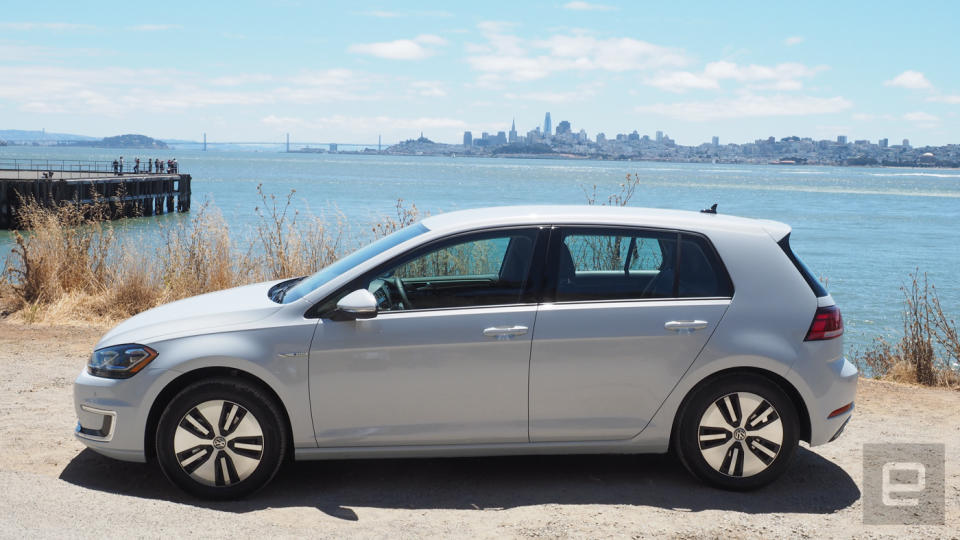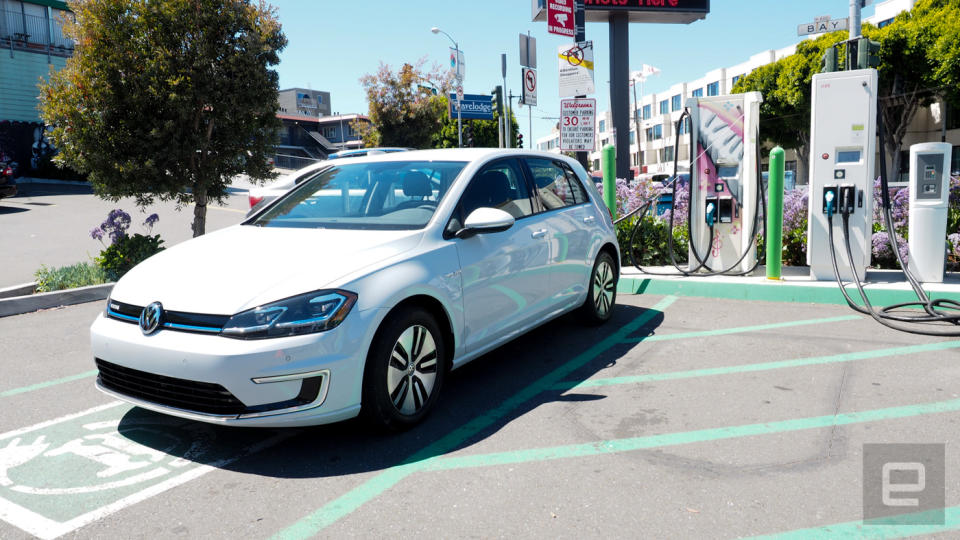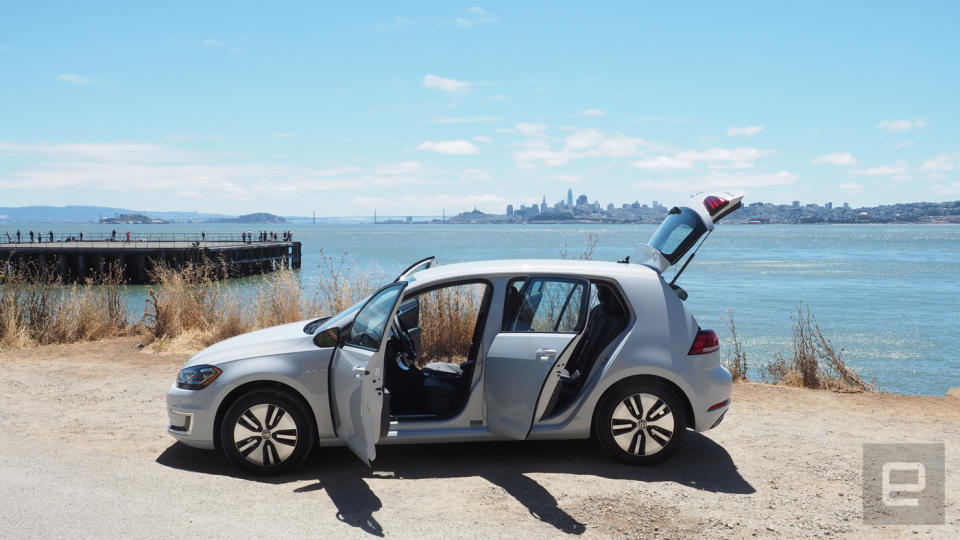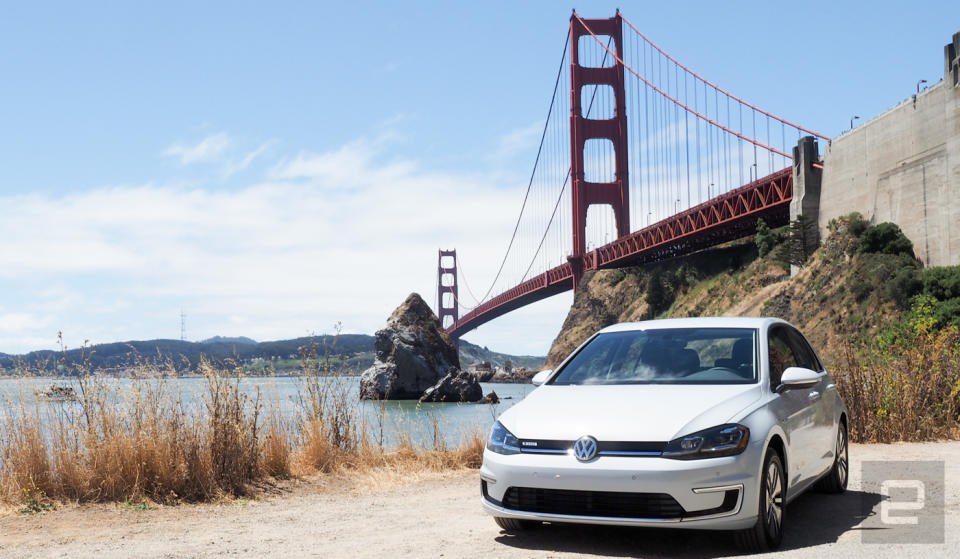Volkswagen’s e-Golf sits in the past while looking to the future
What the hatchback lacks in range, it makes up for in pedigree.
Volkswagen is betting on an electric future. After years of Dieselgate and the public relations and financial fallout of that gaff, the automaker wants to move on. So it's been talking at length about its upcoming electric platform to distance itself from the emissions-cheating scandal. At nearly every auto show, it shows off a concept car that'll drive hundreds of miles on a single charge. The future sounds great, but today the company already has a solid EV on the road, the 2017 e-Golf.
We were impressed by the previous version of this four-door hatchback and this year's upcoming model left just as much of an impact. A majority of that has to do with the fact that it's built on the Golf platform. Volkswagen has had decades to refine the small car without veering away from its fun-to-drive roots. So putting an electric motor and some batteries in the vehicle sounds like a winning move. It is, but it might not be enough.
For fans of the gas-powered Golf, the 2017 e-Golf doesn't disappoint. It's nimble on city streets, in the mountains, and on the highway. The upgraded battery pack gives it even more torque (214 pounds) and jumps the horsepower from 115 to 134. That translates to access to quick jolts of power at any speed. Helpful when trying to get up to highway speed or accelerating out of potentially dangerous driving situations.
Be warned though, the car does top out at 85 miles per hour. That means no blasting down the highway at over 100 miles per hour (which is something you shouldn't be doing in the first place of course). Keep it on the track.

To help you squeeze as much efficiency as possible from the e-Golf it offers three driving modes. Normal for access to all the power. Eco which limits power and some climate control options and Eco+ which severely limits the car's power and completely eliminates climate control. I found both Eco modes perfect for dense city traffic along with the use of the regenerative braking feature. San Francisco summers are notoriously cold, so driving around in Eco+ with the windows down was fine most of the time. Your city's weather and traffic may vary.
With a low center of gravity -- thanks to the batteries and tight steering -- whipping the e-Golf around corners is exhilarating. The car may be electric, but it's also a hot hatch. I'm a big fan of hot hatches.
While it's an electric car, the interior doesn't overload you with extra buttons and dials. Everything is cleanly laid out with the majority of the car's more technical features being handled by the touchscreen infotainment system. The e-Golf (like a growing number of new cars) supports both Android Auto and CarPlay. But if you decide to stick with the factory navigation, you can set the car to display charging stations as points of interest. It's something you'll have to do less of with this version of the car, but it's still something you'll have to tackle more than we would like.

Volkswagen upgraded the e-Golf's battery from 24.2 kWh to 35.8 kWh and along the way extended the range from 83 to 125 miles. An impressive feat considering the size of the battery hasn't changed. In real world tests, I was able to eek out about 118 miles with a majority of those trips being in the city and about 15 percent of that time on a highway.
During my week with the car, I rarely felt concerned about the e-Golf's range. I'd charge at home and on-the-go and mostly stuck to my daily commute routine with an occasional trip to Oakland. Then there was an opportunity to head north beyond the car's comfort range and I immediately thought of the Chevy Bolt.
The biggest issue with the e-Golf is that it exists in a world where the 238-mile range Chevy Bolt is on the road. Both are fun-to-drive hatchbacks with solid electric torque and tight steering. Both have fold down seats and can handle a Costco run or help a friend move. The biggest difference is the Bolt won't need to sit at a charging station as often.
Fortunately, the mid and high-end version of the e-Golf (SEL Premium and Limited Edition respectively) ship with DC fast charging. With it, Volkswagen says the battery will go from zero to 80 charged in less than a hour. We were able to roughly match that during our test.
But even with the option to charge the e-Golf quicker, the range of the vehicle still hangs there in the back of your mind. It's possible, however, that the e-Golf will be $5,000 cheaper than the Chevy Bolt. Volkswagen hasn't announced pricing yet, so we're basing that on the cost of the 2016 model. Drivers will have to decide whether losing 113 mile per charge is worth a $5,000 saving. Again, we're still not sure what the total price will be.

Meanwhile, Volkswagen is pushing its electric vehicle platform, Modular Electric Drive Matrix (MEB -- yeah we know the B should be a D). Over the past year it's been showing off EV concept vehicles with ranges between 250 and 311 miles. It's even getting ready to launch an electrified microbus. But these vehicles won't be on the road until about 2020.
That makes the e-Golf a bit of an electric placeholder. Because it's based on a gas platform, there's not much the automaker can do to extend its range without making drastic changes to the car itself, which makes very little economic sense. Meanwhile the MEB ID vehicles will be built from the ground up to be powered by electrons.

So while the e-Golf feels like it's being left behind by the competition, for folks that want a tried and tested platform it's ready to quietly zip them around town. It'll be unsurprising if the e-Golf disappears once the ID cars make it showrooms, but here's hoping that everything VW learns from the tiny hatchback, it drops in its future cars. Because saving the planet is great, but saving the planet while enjoying your time behind the wheel is how you sell cars.




































